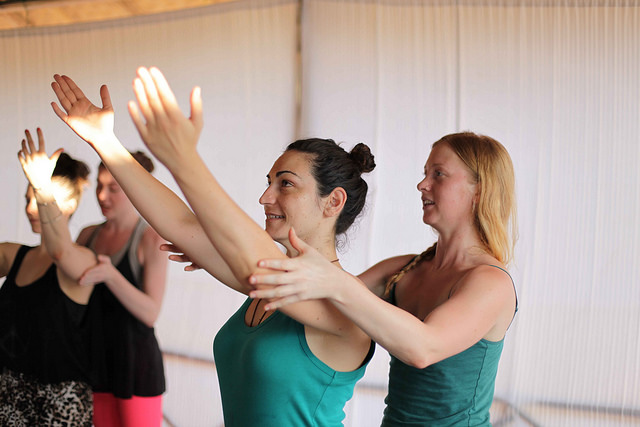Have you ever wondered why some yoga classes feel more magical than others?
When you are in classes like this, it is as though time stands still and all that exists is the movement, your breath, and the voice of the teacher guiding you. All of your thoughts soften as you become transfixed by the flow of your practice.
How is is that some teachers are able to (seemingly effortlessly) create this kind of experience for their students? What sets them apart as an expert guide and leader for your yoga practice?
One of the key pieces a good yoga teacher has in their teaching toolbox is a solid understanding of the practical aspect of guiding students through the postures. This goes a long way in creating confidence and ease while teaching. Learning how to do this is at the forefront of most trainings, and for good reason!
Yet I have come to realize that practical knowledge alone is not the only ingredient in the secret sauce of an exceptional yoga instructor. When a teacher goes beyond teaching the poses and is able to facilitate a flow state for their students, we see the practice magically come alive for both teacher and student. Coined by Mihaly Csikszenymihalyi, flow is described as a state of complete absorption in the experience of the moment.
In the Yoga Sutras, yoga is described in a similar way. Yoga is a state in which the mind ceases to fluctuate. Patanjali uses the word samadhi to describe this state of complete absorption which is comparable to the flow state I mentioned above.
The transcendent feeling of the flow state is why yoga feels different than most other forms of physical fitness. I believe that this is why yoga has become increasingly popular over the last 10 years. Intuitively, we know it is good for us to experience flow states. Yoga speaks to our beleaguered and stressed out culture by giving us the opportunity to slow down our incessant mind chatter.
Stemming from this boom in popularity has been an influx of people wanting to become yoga teachers, and as a result, there are countless yoga teacher training programs being created to meet the demands of an increasing number of students. For many studios, including my own, trainings are not only a necessary part of cash flow but are also an important part of ensuring a healthy pool of instructors to choose from when planning the studio schedule.
With a plethora of yoga teacher training programs available, how does a potential yoga teacher training student decide on which program is right for them?
The following is a list of the top three qualities I think an amazing yoga teacher has, and what you should look for in a training program to ensure you know how to cultivate those qualities for yourself.
1. A good yoga teacher not only understands the practicalities of teaching yoga, they also understand the heart of yoga. They carry what I call the “transmission” of the practice, which is an understanding that goes much deeper than reading a textbook. Transmission is communicated without words and presents itself as a quiet, trustable confidence as a leader and guide of the practice.
What to look for in a training program to cultivate this quality:
Look for a program that has a strong emphasis on personal practice. Make sure practice hours include not only the postures, but also that breathwork and meditation are mandatory requirements for graduation. It is through this holistic approach to practice that the teachings come alive.
When yoga is alive in the body of the teacher, the essence of the practice is easily shared with the students as well. Yoga is a living, breathing practice that goes far beyond understanding how to do a pose technically.
When you are considering a training program, what kind of support and encouragement is the head instructor giving trainees in order to help them build a sustainable lifelong practice?
2. Contrary to what we might see on social media, wearing mala beads and speaking positive affirmations are not the signs of quality yoga instruction. A good yoga teacher shares more than just a few feel good postures and a namaste at the end of class. A good yoga teacher shares who they are at their core, and this can only come from a deep understanding of themselves.
Authenticity wins over phony yoga teacher affectations any day when it comes to relationship building and trust between teachers and students.
What to look for in a training program to cultivate this quality:
Look for a training programs that asks students to dig deep into the practice of svadhyaya, which means self study. Cultivating a strong sense of self-awareness through reading yoga philosophy, and other transformational literature helps teacher trainees develop a deeper level of understanding, which is a prerequisite for living and sharing yoga authentically.
Ultimately, we are only capable of feeling into others to the capacity of which we can feel into ourselves. Quality teaching is about reading your students intuitively and addressing their needs moment to moment. Good teachers do this effortlessly because they have cultivated a strong capacity for empathy, compassion, and unconditional love.
True mastery in this area comes from cultivating it within oneself first and foremost, and self study is a key piece of this process. It is this very real journey of authenticity that resonates with students at a deep level and it is a key piece in effectively being able to share the magic of yoga.
Additionally, having a clear understanding of their inner landscape is invaluable to a yoga instructor when it comes to the risk of burn-out. While it seems like a dream career, teaching yoga requires the capacity to hold space for and share energy with a large number of people every day. Having the discernment to know what to say yes or no to will help to prevent burn-out and frustration while trying to build your career.
Ask yourself if the training program you are considering offers you an opportunity to deep dive into your own process of growth as a student of yoga (and life) first and foremost. It is this self-awareness that will ultimately serve you the most as a yoga teacher and as a human being.
3. A quality yoga teacher is adaptable while teaching their classes; they understand body diversity, and are open to sharing yoga with a growing market of students who are not young, thin, white women. This means being able to think constructively in the moment, being mindful with speech, and having a strong capacity for creativity and compassion when guiding a diverse student base.
What to look for in a training program to cultivate this quality:
Look for a training program that has an excellent yoga anatomy component so that you feel confident guiding all types of bodies through the practice. Good programs will have leaders who are highly skilled in this area or they will utilize materials that are highly respected in the industry.
Another aspect that has become increasingly important is an awareness of how to hold the experience of students who have experienced trauma in their lives. Yoga has been shown to be an extremely effective healing modality for trauma, which means you will inevitably have students in your class who have experienced trauma in some form. While you won’t be expected to be facilitate their healing directly, it is important to be aware of how your teaching language, adjustments, and space holding impact the students in your class who are dealing with trauma. Make sure trauma sensitivity training is part of the program you are considering.
It is also important to look for diversity within the student base of the studio itself. This is a good indication of what kind of students your lead instructor is attracting. Diversity indicates an instructor that is skilled in effortlessly adapting yoga for all bodies and abilities. Make sure you go to a few classes with the lead instructor you are considering and get a feel for how the students are held in the class. If you feel seen, supported, and cared for by the instructor, you can be sure that you will also be supported in the process of learning how to teach yoga.
In the end, authenticity and commitment to their personal growth is what truly lies in the heart of any good teacher and their ability to offer their genuine truth in the service of guiding students through the practice of yoga is what makes them great.
Think about a few of your favorite yoga teachers, and I’m certain you’ll notice they have all of the qualities I’ve mentioned above, and probably a whole lot more as well.
~
~
~
Author: Robin Hilton Bowden
Image: Flickr/The Yoga People
Editor: Travis May

 Share on bsky
Share on bsky







Read 0 comments and reply